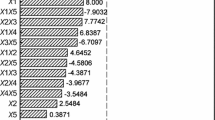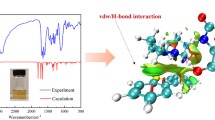A study was carried out on the effect of ionic liquids (morpholine formate and aniline formate) on the desulfurization of catalytic cracking gasoline and coking gasoline. A relationship was found between the extent of desulfurization of the gasolines on the ionic liquid:gasoline ratio and the duration of the extraction. An increase in the ionic liquid: coking gasoline ratio from 1:10, to 1:5, and then 1:1 led to enhancement of desulfurization t o 19.5%, 21.5%, and 49%, respectively. An increase in the ionic liquid: catalytic cracking gasoline ratio from 1:3 to 1:1 led to an increase in the desulfurization of this gasoline from 40.2% to 65.4% for 0.2 h extraction time. When the extraction time was extended to 0.5 h, the desulfurization of catalytic cracking gasoline was enhanced from 50 to 70%.
Similar content being viewed by others
Explore related subjects
Discover the latest articles, news and stories from top researchers in related subjects.Avoid common mistakes on your manuscript.
A problem in petroleum refining is the production of motor fuels in accord with current standards relative to the content of sulfur compounds, requiring the use of secondary refining of the raw petroleum. Such processes are hydrodesulfurization, catalytic cracking, and isomerization. The classical method for hydrodesulfurization of motor fuels is not always economically viable and also leads to a significant drop in the octane number as well as a sharp decrease in the quality of automobile gasolines.
Hence, work is underway to develop alternative methods without the use of hydrogen to reduce the content of sulfur components not affecting the octane number of automobile gasolines. These methods involve adsorption, oxidative desulfurization, and liquid extraction with solvents. Extraction processes are used to reduce the content of sulfur compounds with retention of the unsaturated hydrocarbons and octane number [1, 2]. In order to reduce the content of sulfur compounds with retention of the octane number, alternative methods for the desulfurization of gasoline fractions have been developed using ionic liquids. The major advantages of such liquids as extraction agents are their stability, nonflammability, and good solvation properties. Extraction desulfurization is based on the higher solubility of sulfur compounds in ionic liquids in comparison with hydrocarbons [3,4,5]. This method permits the removal of aromatic sulfur compounds such as thiophenes and dialkyldibenzothiophenes, which are difficult to convert in hydrodesulfurization processes [6, 7].
In the present work, we studied the desulfurization of gasoline fractions using ionic liquids. Catalytic cracking gasoline and coking gasoline, whose characteristics are given in Table 1, were taken as the gasoline fractions for studying the extraction of sulfur compounds by ionic liquids.
The total contents of sulfur compounds in the catalytic cracking gasoline and coking gasoline were 301 and 1842 ppm, respectively. The coking gasoline is a low-octane component of automobile gasolines with motor octane number 67 and has low chemical stability upon storage due to the large amount of unsaturated hydrocarbons, including 34 wt.% dienes.
The chemical composition of the gasolines was studied on a Perkin Elmer Auto System XL chromatograph and BRUKER IR spectrometer.
The ionic liquids were nitrogen-containing compounds with high polarity, namely, morpholine and formic acid as well as aniline formate obtained from aniline and formic acid in 1:1 ratio:

The major physical indices for morpholine formate: density at 20°C) 1.07-1.14 kg/m3, viscosity at 30°C) 6-7 cSt, glassy point temperature) —5°C, and electrical conductivity) 1.1.10'-1.3-10-3 S.
These ionic liquids are hydrophilic and reflux in the range 140-240°C. The desulfurization of gasolines consists of two steps: 1) extraction of the sulfur compounds by the ionic liquids and 2) regeneration of the ionic liquids by distillation of the extract with reuse of the liquids.
Selective desulfurization of the gasoline fractions by ionic liquids was carried out at 20-30°C over 12-30 min with various ratios of the raw material and reagent. After the end of the experiment, the mixture was cooled for 30 min and separated into two layers. The upper layer was the raffinate, which is a desulfurized gasoline phase, while the lower layer is the extract containing the treated ionic liquid and extracted sulfur compounds. The sulfur compound content was determined by a fluorescence method using procedure ASTM D 1319.
The extent of desulfurization of the gasoline fractions was calculated as the difference in the content of sulfur compounds in the raw material and in the raffinate relative to the sulfur compound content in the raw material
where ED is the extent of desulfurization, %, \( {C}_s^0 \) is the sulfur compound content in the raw material, ppm, and Cs is the sulfur compound content in the raffinate, ppm.
A study was carried out on the dependence of the desulfurization of coking gasoline and catalytic cracking gasoline on the ratio of the ionic liquid to the gasoline with extraction time 0.2 h at 25°C.
An increase in the ratio of the ionic liquid to coking gasoline leads to an increase in the desulfurization of the gasolines from 19.5 to 49.0% and a decrease in the sulfur compound content from 1842 to 940 ppm along with a decrease in the content of unsaturated hydrocarbons in the coking gasoline from 34 to 30% (i.e., by 9.41-11.76%), which gives a slight drop in the octane number. The yield of the extract from coking gasoline and catalytic cracking gasoline is from 8 10 12 vol. % and from 9.5 10 10 vol. %, respectively (see Table 2).
Table 3 gives the sulfur compound content in the isolated extracts of coking gasoline and catalytic cracking gasoline. Since the extract yield does not exceed 8-12% of the raw material and the sulfur compound content in both is insignificant, after separation of the ionic liquid from the extract, these flows can be introduced into a unit for hydrodesulfurization together with the raw material of catalytic cracking, namely, vacuum gas oil or catalytic cracking gasoline, such that losses in this process do not exceed the usual values.
For catalytic cracking gasoline, increasing the ratio of the ionic liquid to the catalytic cracking gasoline from 1:3 to 1:1 leads to an increase in the extent of desulfurization from 40.2% to 65.4%. In this case, the sulfur compound content was reduced from 301 to 104 ppm with only a slight decrease in the unsaturated hydrocarbon content and the gasoline octane number. The extent of desulfurization of catalytic cracking gasoline with 1:1 ratio of the ionic liquid to gasoline exceeds the extent of desulfurization of coking gasoline by a factor of 1.33 under the same conditions (see Table 2).
An increase in the extraction time to 0.5 h leads to an increase in the extent of desulfurization of catalytic cracking gasoline to 50.0-70.1% (Table 4).
The extent of desulfurization also depends on the sulfur compound content in the gasoline. Table 5 gives data on the desulfurization of coking gasoline with 2528 ppm sulfur compounds and 41.07% olefins with 0.2 h extraction time using morpholine formate as the ionic liquid.
Raising the ratio of the ionic liquid to coking gasoline from 1:19 to 1:14 and then 1:10 leads to increased desulfurization from 10% to 15.2% and then 17.5%, respectively (see Table 5). For the same 1:10 ratio of ionic liquid to coking gasoline, the extent of desulfurization of coking gasoline with 1842 and 2528 ppm sulfur compounds is 19.5% (see Table 2) and 17.5% (see Table 5), respectively.
A study was carried out on two batches of coking gasoline with 1842 and 2528 ppm sulfur compounds with the same ratio of ionic liquid to coking gasoline equal to 1:10 and 1:5 (Table 6). These results showed that for a 1:10 ratio of ionic liquid to coking gasoline and 1842 and 2528 ppm sulfur compounds in the coking gasoline, the extent of desulfurization decreases from 19.5% to 17.5% and, correspondingly, for a 1:5 ratio of ionic liquid to coking gasoline, the desulfurization drops from 21.7% to 19.8%.
The desulfurization of coking gasoline was also carried out using aniline formate as the ionic liquid with 1:10, 1:5, and 1:1 ratio of the ionic liquid to coking gasoline at 25°C (Table 7).
Raising the ratio of ionic liquid to coking gasoline from 1:10 to 1:5 and then 1:1 leads to an increase in the extent of desulfurization from 11.3% to 44.2%, respectively. The unsaturated hydrocarbon content in the raffinate is reduced by 3.75-6.25%. These experiments show that the desulfurizing capacity of morpholine formate under identical purification conditions and 1842 ppm sulfur compound content is somewhat higher than for aniline formate. The values for 1:10, 1:5, and 1:1 ratio are 19.5%, 21.5%, and 49%, respectively (see Table 2).
IR spectra were taken for samples of the starting coking gasoline and the raffinate and extract separated from it. The IR spectrum of the extract shows the following absorption bands (D): deformation (1377, 1455 cm-1) and stretching vibrations (2856, 2923, and 2955 cm-1) for CH, CH3, and CH2 groups, deformation (694, 728, 741, 768, 887, and 1606 cm-1) vibrations for CH bonds of substituted benzene rings, and deformation (909, 965 cm-1) and stretching vibrations (1642 cm-1) of kene C=C bonds with intensity much higher than in coking gasoline, which indicates a decreased amount of unsaturated hydrocarbons in the raffinate.
Table 8 gives the optical density of the components of the starting coking gasoline and the raffinate and extract separated from it. The C=C bonds in the alkenes are in the a position and have trans configuration.
The coking gasoline contains a large amount of reactive unsaturated hydrocarbons and, as a consequence, has low chemical stability. The presence of unsaturated hydrocarbons is undesirable since such compounds are chemically unstable and tar and precipitates are formed upon the storage of such gasoline.
The removal of unsaturated hydrocarbons from coking gasoline by extraction using ionic liquids leads to improved chemical stability and storage period of the gasolines without separation into layers for up to 10-12 months. The color of the gasolines is also improved. Thus, these ionic liquids display high desulfueizing and stabilizing activity and permit a reduction of sulfur compounds by 50-70% with virtually no decrease in the octane number of the gasolines. These are considered alternative methods and can be carried out without the use of a hydrogen-containing gas as in hydrodesulfuriza.tion, i.e., virtually without decreasing the gasoline octane number.
In this work, we investigated alternative methods for eliminating sulfur compounds in gasoline fractions using ionic liquids (morpholine formate and aniline formate) while hardly reducing the octane number of the gasolines. The extent of desulfurization was found to depend on the ratio of the ionic liquid to coking gasoline, the temperature and duration of extraction, and the sulfur compound content in the raw material. The extracts obtained after distilling off the ionic liquid may be transferred to a unit for hydrodesulfurization along with the raw material of catalytic cracking, namely, gas oil or catalytic cracking gasoline.
References
W. Wan Mokhtar, W. Abu Bakar, and A. Rusmidah, Journal of the Taiwan Institute of chemical Engineers, 35, 314-319 (2014).
I. V. Smolyaninov, V. V. Kuz'min, and N. S. Dzhuvalyakova, Geologiya, Geografiya i Global'naya Energiya, 54, No. 3, 126-129 (2014).
A. A. Gaile and B. M. Saifidinov, Alternative Non-Hydrogenation Methods for Improving the Quality of Diesel Fuel [in Russian], St. Petersburg State Institute of Technology, St. Petersburg (2009).
C. Song, Catalysis Today, 86, Nos. 1-4, 211-263 (2003).
I. V. Babich and J. A. Moulijn, Fuel, 82, No. 6, 607-613 (2003).
A. V. Akopyan, Oxidative Desulfurization of Hydrocarbon Raw Material by Hydrogen Peroxide in the Presence of Thansition Metal Salts [in Russian], Chemical Sciences Candidate's Dissertation, Moscow (2015).
G. Chatel, J. F. B. Pereira, V. Debbeti, et al., Green Chem., 16, No. 4, 2051-2083 (2014).
Author information
Authors and Affiliations
Corresponding author
Additional information
Translated from Khimiya i Tekhnologiya Topliv i Masel, No. 4, pp. 28 — 3 1 , July — August, 2018.
Rights and permissions
About this article
Cite this article
Mirzoeva, L.M., Ibragimova, M.D., Nagiev, V.A. et al. Use of Ionic Liquids for Desulfurization of Gasoline Fractions. Chem Technol Fuels Oils 54, 430–437 (2018). https://doi.org/10.1007/s10553-018-0944-5
Published:
Issue Date:
DOI: https://doi.org/10.1007/s10553-018-0944-5




